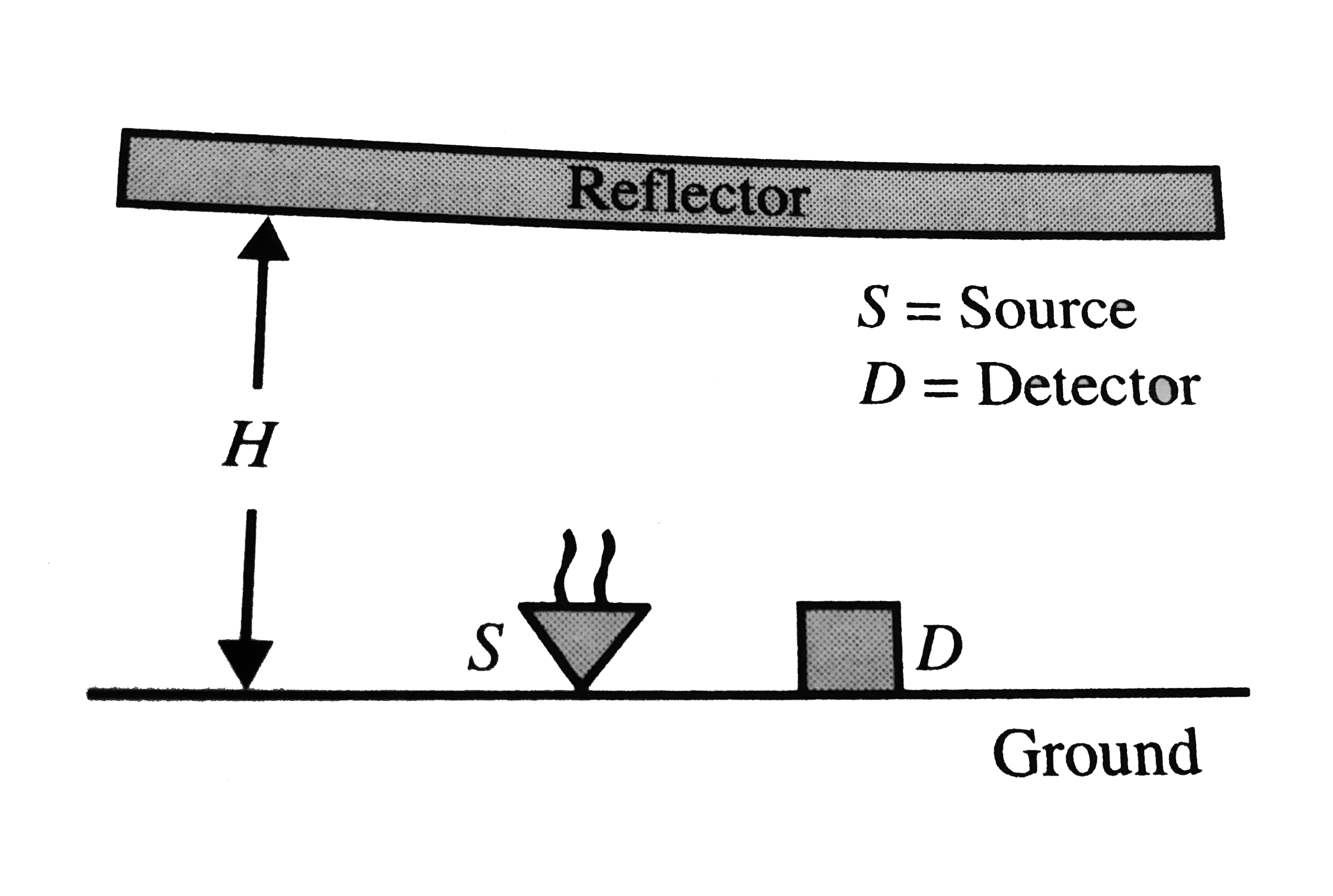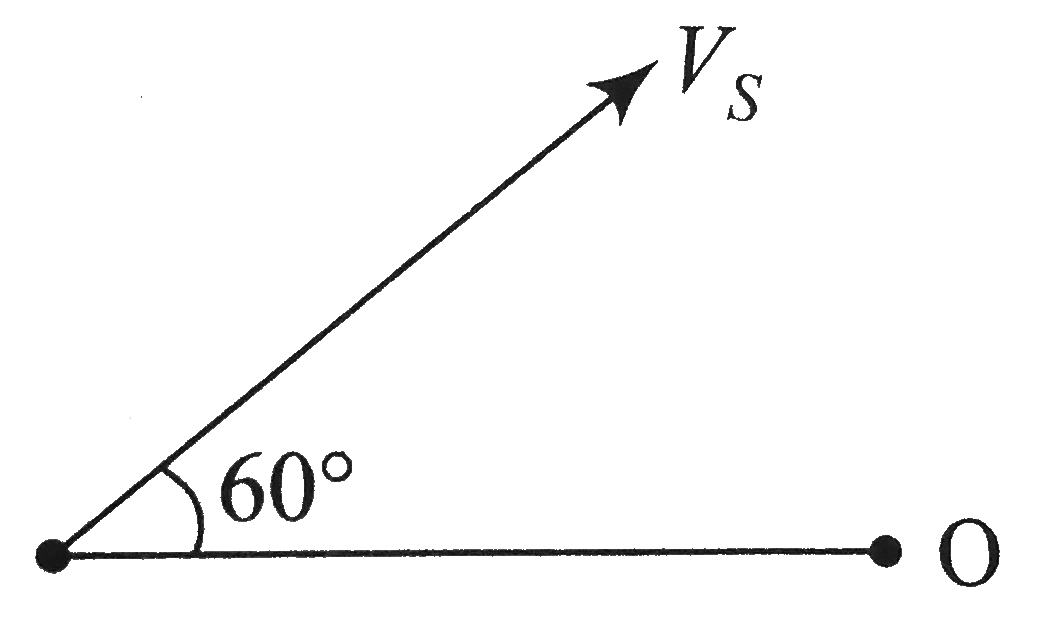A source emitting electromagnetic signals with proper frequency ω0 = 3.0.1010 s-1 moves at a constant velocity v = 0.80 c along a straight line separated from a stationary observer P by a distance l Fig. 5.37. Find the frequency of the signals perceived by the observer at the moment when a the source is at the point O; b the observer sees it at the point O.
a If light is received by the observer at P at the moment when the source is at O it must have been emitted by the source when it was at O and travelled along OP. Then if OP = c t OO = v tIn the frame of the observer the frequency of the light is ω while its wave vector iswe can calculate the value of ω by relating it to proper frequency ω. The relation isTo derive the formula is this form it is easiest to note that is an invariant which takes the value ω0 in the rest frame of the source.b For the light to be received at the instant observer sees the source at O light must be emitted when the observer is at O at 90° = θIn this case the observer will receive light along OP and he will “see” that the source is at O even though the source will have moved ahead at the instant the light is received.
Related Solutions
A source emitting electromagnetic signals with proper frequency moves at a constant velocity along a stright line separated from a stationary observer by a distance (Fig.) Find the frequency of the singnals perceived by the observer at the moment when
(a) the source is at the point ,
(b) the observer sees it at the point .

View SolutionA source of sound with natural frequency f_0=1800Hz moves uniformly along a straight line separated from a stationary observer by a distance l=250m . The velocity of the source is equal to eta=0.80 fraction of the velocity of the sound. Q. The distance between the source and the observer at the moment when the observer receives a frequency f=f_0 is
View SolutionA source of sound with natural frequency f_0=1800Hz moves uniformly along a straight line separated from a stationary observer by a distance l=250m . The velocity of the source is equal to eta=0.80 fraction of the velocity of the sound. Q. The distance between the source and the observer at the moment when the observer receives a frequency f=f_0 is
View SolutionA source of sound with natural frequency moves uniformly along a straight line separated from a stationary observer by a distance . The velocity of the source is equal to fraction of the velocity of the sound.
Q. Find the frequency of osund received by the observer at the moment when the source gets closest to him.

View SolutionA source of sound with natural frequency f_0=1800Hz moves uniformly along a straight line separated from a stationary observer by a distance l=250m . The velocity of the source is equal to eta=0.80 fraction of the velocity of the sound. Q. Find the frequency of osund received by the observer at the moment when the source gets closest to him.
View SolutionA source of sound with natural frequency f_0=1800Hz moves uniformly along a straight line separated from a stationary observer by a distance l=250m . The velocity of the source is equal to eta=0.80 fraction of the velocity of the sound. Q. Find the frequency of osund received by the observer at the moment when the source gets closest to him.
View SolutionA sound source S is moving along a straight track with speed v, and is emitting sound of frequency (see figure). An observer is standing at a finite distance at the point O, from the track . The time variation of frequency heard by the observer is best respresent by :
( represents the instant when the distance between the source and observer is minimum )
View SolutionA sound source S is moving along a straight track with speed v, and is emitting sound of frequency v_0 (see figure). An observer is standing at a finite distance at the point O, from the track . The time variation of frequency heard by the observer is best respresent by : ( t_0 represents the instant when the distance between the source and observer is minimum )
View SolutionA sound source S emits waves of frequency 100Hz and an observer O is located at some distance from the source. Source 19.4ms^(-1) velocity along the source observer line 60^(@) moving at an angle of as shown in the figure. The observer is at rest. What is the virtual frequency observed by the observer? (velocity of sound in air 330ms^(-1) Is)
View SolutionA source of sound of frequency moves unifornly along a straight line with velocity times velocity of sound . An observer is located at a distance from this line. Find
(a) the frequency of the sound at instant when the source is closest to the observer.
(b) the distance of the source when he observer no change in the frequency.
View SolutionA source of sound of frequency moves unifornly along a straight line with velocity times velocity of sound . An observer is located at a distance from this line. Find
(a) the frequency of the sound at instant when the source is closest to the observer.
(b) the distance of the source when he observer no change in the frequency.
View SolutionA source of sound with natural frequency v_(0) moves uniformly along a straight line separated from a stationary observer by a distance l . The velocity of the source is equal to eta fraction of velocityof sound. Find the frequency of sound received by the observer at the moment when the source gets closest to him and also find the distance between the source and the observer at the moment, when the observer receives a frequency v = v_(0)
View SolutionA source of sound with natural frequency n = 1800 Hz moves, uniformly along a straight line separated from a stationary observer by a minimum distance d = 250m. The velocity of the source is equal to 0.8v, v being speed of sound. The frequency of sound received by the observer at the moment when the source gets closest to him is 1000x. Then x
View SolutionA source of sound with natural frequency n = 1800 Hz moves, uniformly along a straight line separated from a stationary observer by a minimum distance d = 250m. The velocity of the source is equal to 0.8v, v being speed of sound. The frequency of sound received by the observer at the moment when the source gets closest to him is 1000x. Then x
View Solution
A source of sound emitting waves of frequency and an observer are located at some distance from each other. The source is moving with a speed of at an angle of with the source observer line as shown in the figure. The observer is at rest. The apparent frequency observed by the observer (velocity of sound in air ) is
View SolutionA source of sound S emitting waves of frequency 100 Hz and an observer O are located at some distance from each other. The source is moving with a speed of 19.4ms^-1 at an angle of 60^(@) with the source observer line as shown in the figure. The observer is at rest. The apparent frequency observed by the observer (velocity of sound in air 330ms^-1 ) is
View SolutionWhen a source moves away from stationary observer with velocity v then apparent change in frequency is Deltan_(1) . When an observer approaches the stationary source with same velocity v then change in frequency is Deltan_(2) then
View SolutionAn observer moving towards a stationary source observes that the apparent frequency is three times the actual frequency of the source. If the velocity of sound is V, the velocity of the observer would be-
View SolutionIf a source sounding a whistle with a constant frequency moves in a circle and frequencies observed by observer O, when the source is at points A, B, C be v_(a) , v_(b) , v_(c) ,then
View SolutionIf a source sounding a whistle with a constant frequency moves in a circle and frequencies observed by observer O, when the source is at points then :-

View Solution